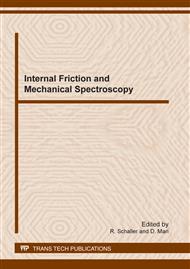p.221
p.227
p.233
p.239
p.245
p.251
p.257
p.265
p.271
Stress Relaxation Behavior of Cu-Ni-P Alloys Evaluated from Amplitude-Dependent Internal Friction
Abstract:
The strain-amplitude dependence of internal friction in Cu-0.41Ni-0.11P (mass%) alloys has been evaluated to reveal the relation between the amplitude-dependent internal friction and the stress relaxation performance. Annealing at 250°C after cold rolling causes a suppression of the strain-amplitude dependence with increasing annealing time in the range between 10 s and 104 s. Analysis of the amplitude-dependent internal friction reveals the plastic strain of the order of 10-9 as a function of effective stress on dislocation motion. It is found that the microflow stress at a constant level of plastic strain increases with increasing annealing time. This result is in line with the improvement in the stress relaxation performance but disagrees with a decrease in the tensile strength and yield stress after annealing. We believe that the increase in the microflow stress after annealing is caused by inhibition of dislocation motion due to Ni-P clusters, which were revealed by three-dimensional atom probe (3DAP) experiments.
Info:
Periodical:
Pages:
245-250
Citation:
Online since:
January 2012
Authors:
Price:
Сopyright:
© 2012 Trans Tech Publications Ltd. All Rights Reserved
Share:
Citation:


